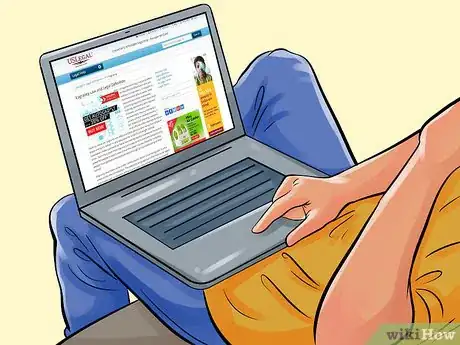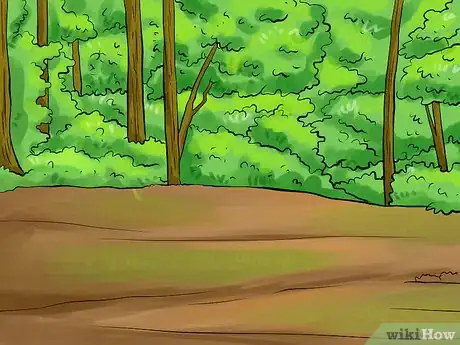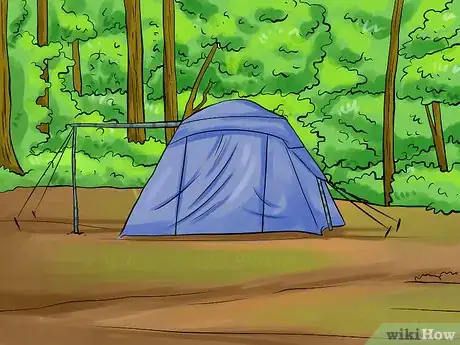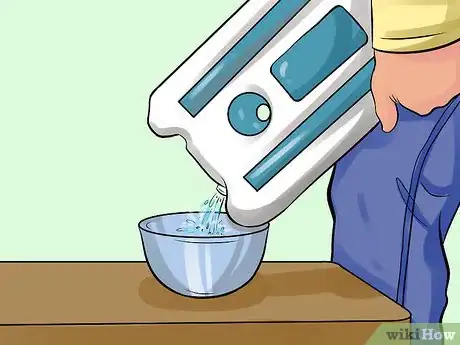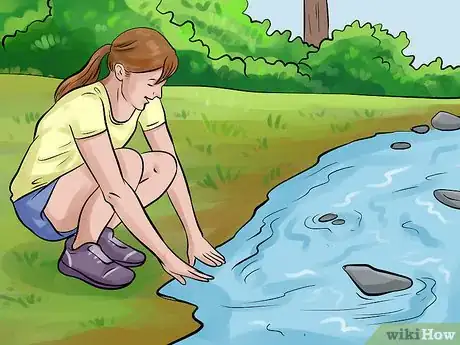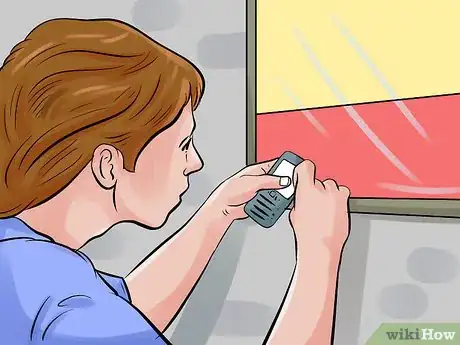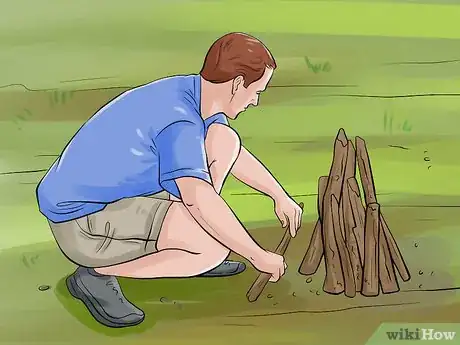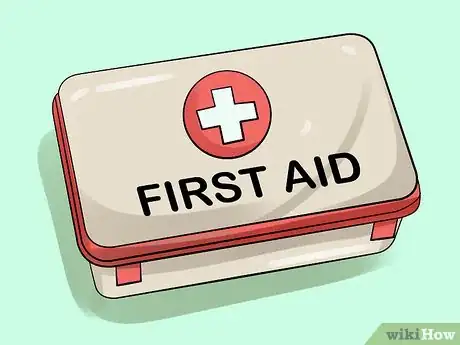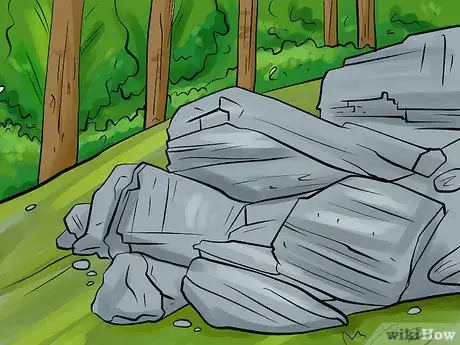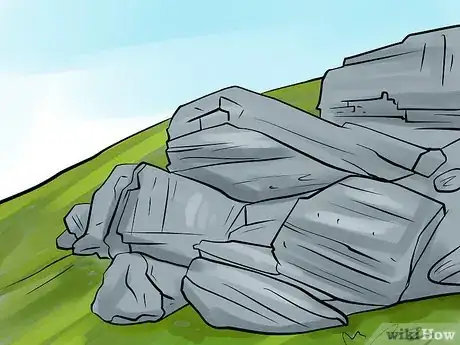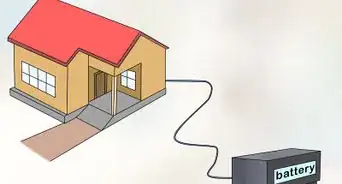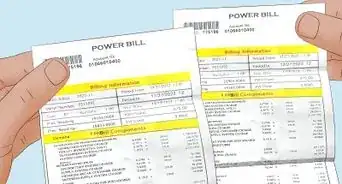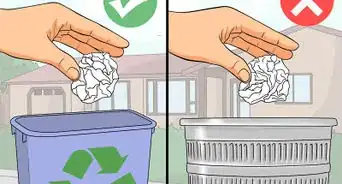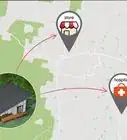This article was co-authored by Britt Edelen. Britt Edelen was an active member of his local Boy Scouts troop near Athens, Georgia from ages 8 to 16. As a Scout, he went on dozens of camping trips, learned and practiced many wilderness survival skills, and spent countless hours appreciating the great outdoors. In addition, Britt worked as a counselor for several summers at an adventure camp in his hometown, which allowed him to share his passion for and knowledge of the outdoors with others.
There are 12 references cited in this article, which can be found at the bottom of the page.
This article has been viewed 79,240 times.
Living outdoors is the ultimate dream for some; for others, it may be a necessity. Whether you are in need of shelter or simply want to travel from city to city, camp out in the wilderness, or disconnect from the world, you will need some basic supplies and survival skills. The most important thing of all is to build a secure shelter with access to clean water, food, and other necessities. Survival skills and emergency preparation will ensure that you are healthy and safe.
Steps
Finding Shelter
-
1Check your local laws. While you may plan to live in a public park or state forest, understand that it may be illegal to live in these areas. Make sure that there are no rules about sleeping in public or forbidding "vagrancy."[1] In state and national parks, check to see if you need a camping license.
- You can research laws on a city or state website or by visiting a county law library. State and national park guidelines are usually listed on their website.
- Never trespass on somebody else's land. You could be fined or arrested.
-
2Choose a suitable location. Location is everything. You should find a safe area where you can set up your shelter without being disturbed. If you are in a city or urban area, you might be limited in where you can set up, but in the wilderness, you just have to find a secure location.
- In a town, you may be able to set up a shelter under a bridge, at the beach or park, or just outside city limits.
Advertisement -
3Build a shelter. While you can always sleep under the stars, you should have some sort of shelter to protect yourself from wild animals, bad weather, or wind. You can easily make your own shelter out of local materials or from a tarp.[2]
- A tent is the easiest and most convenient form of shelter.[3] If you don’t have a tent, you can hang a tarp between two trees for a similar effect.
- If you are living in a hot, dry climate, you might build a ramada. This is a roof suspended on poles without walls.
- If you are living in snowy conditions, try a snow cave or an igloo. A quinzhee is also an option. This is a dome made out of snow with a hollow inside.
- Use whatever materials you have on hand for the shelter. If you don't have a tarp, for example, you can use garbage bags or an old raincoat.
-
4Get a sleeping bag. A good sleeping bag will insulate you during cold or nasty weather, and it provides a certain degree of comfort as well. Try to invest in a good sleeping bag that you can carry with you wherever you go.
- If you need to make your own bed, insulate the ground with a tarp, leaves, ferns, blankets, or other materials to help keep heat in your shelter and your bed.[4] Cover yourself with a tarp or blanket if possible.
Providing for Your Basic Needs
-
1Identify sources of food. You can always buy food to eat, but if you are trying to save money, make sure that you can find free sources of food. You can forage for food in both urban and wild environments.[5]
- Research your local region to find out what types of edible greens, nuts, flowers, berries, mushrooms, and fruits grow there. Dandelions, watercress, cattails, strawberries, blackberries, morel mushrooms, and acorns are common wild foods in the US.
- If you are in a town, you might ask a grocery store or restaurant about taking foods that they would otherwise throw out. Usually these foods are too old to sell, but they are still good to eat.
- You can always visit a food bank, soup kitchen, or a welfare agency for assistance.
-
2Carry fresh water at all times. Carry a bottle or two of fresh water everywhere. You can get water from rivers, lakes, or streams.[6] You can also collect rainwater in jugs or buckets. If you are near populated areas, you can get water from a water fountain, public restroom, or restaurant.[7]
- Reuse plastic water or soda bottles. These are a much cheaper option than buying a fancy bottle.
- Make sure to purify any water if it came from a natural source. The easiest way to do this is to boil the water first. You can also use a water pump or treat it with iodine.
-
3Locate places where you can bathe. Good hygiene is important, even if you are living outside. A bath or shower can help keep you clean and healthy. It will also reduce the risk of infection.[8]
- You can buy a one-day gym pass to use the bathrooms at a gym. You might also be able to pay for a shower at a truck stop.
- Homeless shelters and public pools often have showers that you can use for free.
- Natural sources of water, such as rivers, streams, and lakes, can be used for baths. Just make sure that you are not in a populated area where nudity is not allowed.
- If you want to clean your clothes, go to the closest laundromat. You can also wash them in a clean lake or stream.
-
4Make use of public facilities. If you are living outdoors, you may still want access to technology, electricity, and other aspects of modern life. You can always rely on public spaces to get these without having to live indoors.
- If you need to charge your phone, you may be able to find a café, library, or bus stop that will let you use their outlets.
- If you want to use a computer, go to a public library. If you own a laptop, cafes, bookstores, malls, and libraries often have free public wifi.
- Homeless shelters can give you a roof over your head during storms or if you just need a break from the outdoors.
Surviving the Outdoors
-
1Learn survival skills. If you want to live in the wilderness, you need to learn specialized skills to help you survive. You can take a class on wilderness survival or read wilderness survival manuals, outdoor magazines, and nature blogs. Go the library to use their computers or books for free. Research the dangers of your region as well. Important skills to learn include:[9]
- Building a fire
- Cooking food
- Healing minor injuries
- Foraging for safe foods
- Fishing
-
2Bring a first aid kit. No matter where you are going or how experienced you are, you should carry basic medical supplies at all times. Keep your supplies in a waterproof container. A good first aid kit should include:[10]
- Gauze and waterproof dressings
- Adhesive bandages
- Tweezers
- Antibiotic cream
- Ibuprofen or acetaminophen
- Any required prescription medications
-
3Dress appropriately. What you wear is one of the most vital aspects of survival. Make sure that your clothes are right for your local climate. As a general rule, always wear one more layer than you need.[11]
- Choose fabrics that will dry quickly and which will provide warmth even if wet. Go with wool if you can. Avoid cotton.
- Keep a waterproof shell, jacket, poncho, or raincoat in case of rain or snow.
- Wear sturdy shoes. Make sure to have warm socks on underneath.
- If you live in a place with cold winters, you will need insulated and layered clothing. Cover every part of your body, including your hands, head, face, and neck.[12]
- Visit thrift stores, clothing donation sites, and charities for cheap or free clothing for all seasons. You can even find winter coats at low cost.
-
4Protect yourself from weather. If there is a storm, snowstorm, tornado, or other dangerous weather, you will need to make sure you can survive it. This means that you may need to find alternate shelter during these events.[13]
- If you are living near an urban environment, you might go a public building to wait out the storm.
- Find a ditch or a low-lying crevice if there is a tornado.
- Rockwall and boulders can provide shelter from the wind.
- Avoid tall structures during lightning storms. In the woods, go to a low-lying area or find shelter under smaller trees away from the larger trees. In an open field, go to the lowest area possible, and crouch down.[14]
-
5Create an emergency plan. It is important that you can get medical attention or rescue if you need it. Determine now how you will contact the authorities should you become injured, lost, ill, or stuck.
- Always let someone know where you are living. Ask them to check up on you periodically.
- You should always have a way to contact help, even if you live in remote wilderness. This could be a satellite phone, a cell phone, a two-way radio, or flares.
Expert Q&A
-
QuestionWhat do I need to survive outdoors?
 Britt EdelenBritt Edelen was an active member of his local Boy Scouts troop near Athens, Georgia from ages 8 to 16. As a Scout, he went on dozens of camping trips, learned and practiced many wilderness survival skills, and spent countless hours appreciating the great outdoors. In addition, Britt worked as a counselor for several summers at an adventure camp in his hometown, which allowed him to share his passion for and knowledge of the outdoors with others.
Britt EdelenBritt Edelen was an active member of his local Boy Scouts troop near Athens, Georgia from ages 8 to 16. As a Scout, he went on dozens of camping trips, learned and practiced many wilderness survival skills, and spent countless hours appreciating the great outdoors. In addition, Britt worked as a counselor for several summers at an adventure camp in his hometown, which allowed him to share his passion for and knowledge of the outdoors with others.
Outdoor Educator The most important thing to find is a source of fresh water. If you find a river or a stream, follow it as far upstream as you can since the water will be cleaner. Also, you should find a place that is far away from any potential hazards (such as cliffs, rockfalls, avalanches, or flooding).
The most important thing to find is a source of fresh water. If you find a river or a stream, follow it as far upstream as you can since the water will be cleaner. Also, you should find a place that is far away from any potential hazards (such as cliffs, rockfalls, avalanches, or flooding). -
QuestionMe and a few others are thinking of walking across our state. There are vast areas of fields and forests. Where would you suggest we sleep?
 Community AnswerGolly that trip sounds like a blast! Take a few light and portable tents to provide shelter. Bring sleeping bags to sleep in. Another option would be to get a hammock that's good for travel (like an ENO) and hang that up between trees. In terms of WHERE to sleep, I would suggest a dry, flat place. Stay away from mud and rocks. A grassy place is fine and all, just watch out for snakes.
Community AnswerGolly that trip sounds like a blast! Take a few light and portable tents to provide shelter. Bring sleeping bags to sleep in. Another option would be to get a hammock that's good for travel (like an ENO) and hang that up between trees. In terms of WHERE to sleep, I would suggest a dry, flat place. Stay away from mud and rocks. A grassy place is fine and all, just watch out for snakes. -
QuestionI want to sleep in my shed for a night. It has a sofa to sleep on. What will I need?
 PearlbelleTop AnswererA blanket and a pillow for you to sleep with and food and water, if you need them during the night.
PearlbelleTop AnswererA blanket and a pillow for you to sleep with and food and water, if you need them during the night.
Warnings
- Don't stay at homeless shelters unless you have nowhere else to go. They typically have limited resources that should be used on people who need it most.⧼thumbs_response⧽
- Make sure you are not trespassing when finding a place to rest, as this results in legal actions. Public areas are usually good places to rest, but can be difficult to rest, due to the harassment of outsiders.⧼thumbs_response⧽
References
- ↑ https://www.nlchp.org/documents/No_Safe_Place
- ↑ http://www.outdoorlife.com/photos/gallery/hunting/2013/05/survival-shelters-15-best-designs-wilderness-shelters#page-4
- ↑ Britt Edelen. Outdoor Educator. Expert Interview. 7 February 2020.
- ↑ http://www.wildernesscollege.com/wilderness-survival-shelters.html
- ↑ http://www.motherearthnews.com/real-food/foraging-wild-edible-plants?pageid=3#PageContent3
- ↑ Britt Edelen. Outdoor Educator. Expert Interview. 7 February 2020.
- ↑ http://www.wildernesscollege.com/basic-survival-skills.html
- ↑ https://wandrlymagazine.com/article/showering-bathrooms/
- ↑ http://www.wildernesscollege.com/basic-survival-skills.html
- ↑ https://www.wildmed.com/blog/building-a-wilderness-first-aid-kit/
- ↑ http://survivalcache.com/wilderness-survival/
- ↑ http://wilderness.org/article/45-tips-foolproof-fall-camping
- ↑ http://www.motherearthnews.com/diy/winter-shelter-ze0z1301zsau
- ↑ http://www.wildbackpacker.com/wilderness-survival/articles/surviving-a-lightning-storm/
